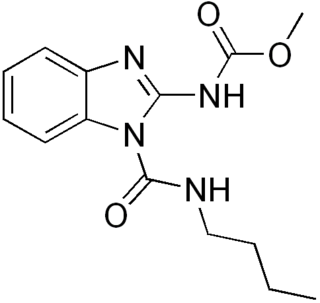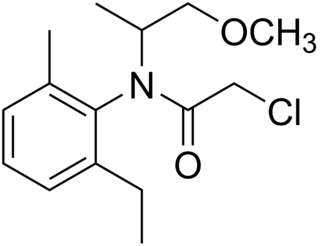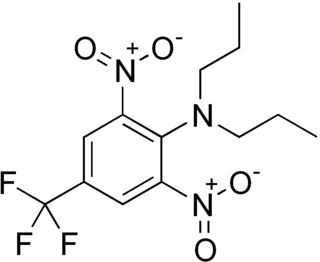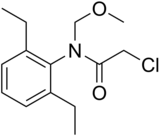
Herbicides, also commonly known as weedkillers, are substances used to control undesired plants, also known as weeds. Selective herbicides control specific weed species, while leaving the desired crop relatively unharmed, while non-selective herbicides can be used to clear waste ground, industrial and construction sites, railways and railway embankments as they kill all plant material with which they come into contact. Apart from selective/non-selective, other important distinctions include persistence, means of uptake, and mechanism of action. Historically, products such as common salt and other metal salts were used as herbicides, however these have gradually fallen out of favor and in some countries a number of these are banned due to their persistence in soil, and toxicity and groundwater contamination concerns. Herbicides have also been used in warfare and conflict.
Roundup is the brand name of a systemic, broad-spectrum glyphosate-based herbicide originally produced by Monsanto, which Bayer acquired in 2018. Glyphosate is the most widely used herbicide in the United States. As of 2009, sales of Roundup herbicides still represented about 10 percent of Monsanto's revenue despite competition from Chinese producers of other glyphosate-based herbicides. The overall Roundup line of products, which includes genetically modified seeds, represented about half of Monsanto's yearly revenue. The product is marketed to consumers by Scotts Miracle-Gro Company.

Glyphosate is a broad-spectrum systemic herbicide and crop desiccant. It is an organophosphorus compound, specifically a phosphonate, which acts by inhibiting the plant enzyme 5-enolpyruvylshikimate-3-phosphate synthase. It is used to kill weeds, especially annual broadleaf weeds and grasses that compete with crops. Its herbicidal effectiveness was discovered by Monsanto chemist John E. Franz in 1970. Monsanto brought it to market for agricultural use in 1974 under the trade name Roundup. Monsanto's last commercially relevant United States patent expired in 2000.

Dicofol is an organochlorine pesticide that is chemically related to DDT. Dicofol is a miticide that is very effective against spider mite.

Chlorfenvinphos is the common name of an organophosphorus compound that was widely used as an insecticide and an acaricide. The molecule itself can be described as an enol ester derived from dichloroacetophenone and diethylphosphonic acid. Chlorfenvinphos has been included in many products since its first use in 1963. However, because of its toxic effect as a cholinesterase inhibitor it has been banned in several countries, including the United States and the European Union. Its use in the United States was cancelled in 1991.

Atrazine is a herbicide of the triazine class. It is used to prevent pre-emergence broadleaf weeds in crops such as maize (corn) and sugarcane and on turf, such as golf courses and residential lawns. Atrazine's primary manufacturer is Syngenta and it is one of the most widely used herbicides in the United States and Australian agriculture.

Benomyl is a fungicide introduced in 1968 by DuPont. It is a systemic benzimidazole fungicide that is selectively toxic to microorganisms and invertebrates, especially earthworms, but nontoxic toward mammals.
Chloropicrin, also known as PS and nitrochloroform, is a chemical compound currently used as a broad-spectrum antimicrobial, fungicide, herbicide, insecticide, and nematicide. It was used as a poison gas in World War I. Its chemical structural formula is Cl3CNO2.

Fenthion is an organothiophosphate insecticide, avicide, and acaricide. Like most other organophosphates, its mode of action is via cholinesterase inhibition. Due to its relatively low toxicity towards humans and mammals, fenthion is listed as moderately toxic compound in U.S. Environmental Protection Agency and World Health Organization toxicity class.

Acetochlor is an herbicide developed by Monsanto Company and Zeneca. It is a member of the class of herbicides known as chloroacetanilides. Its mode of action is elongase inhibition, and inhibition of geranylgeranyl pyrophosphate (GGPP) cyclization enzymes, part of the gibberellin pathway. It carries high risks of environmental contamination.

Dicamba is a broad-spectrum herbicide first registered in 1967. Brand names for formulations of this herbicide include Dianat, Banvel, Diablo, Oracle and Vanquish. This chemical compound is a chlorinated derivative of o-anisic acid.

Metolachlor is an organic compound that is widely used as an herbicide. It is a derivative of aniline and is a member of the chloroacetanilide family of herbicides. It is highly effective toward grasses.

Pesticide drift refers to the unintentional diffusion of pesticides and the potential negative effects of pesticide application, including off-target contamination due to spray drift as well as runoff from plants or soil. This can lead to damage in human health, environmental contamination, and property damage.
Pesticides in the United States are used predominantly by the agricultural sector, but approximately a quarter of them are used in houses, yards, parks, golf courses, and swimming pools.

Trifluralin is a commonly used pre-emergence herbicide. With about 14 million pounds (6,400 t) used in the United States in 2001, it is one of the most widely used herbicides. Trifluralin is generally applied to the soil to provide control of a variety of annual grass and broadleaf weed species. It inhibits root development by interrupting mitosis, and thus can control weeds as they germinate.

Bensulide is a selective organophosphate herbicide. It is one of a few organophosphate compounds that are used as an herbicide. Most of the others are used as insecticides. It is used on vegetable crops such as carrots, cucumbers, peppers, and melons and in cotton and turfgrass to control annual grasses such as bluegrass and crabgrass and broadleaf weeds. It is often applied before the weed seeds germinate (pre-emergence) in order to prevent them from germinating. It is available as granules or an emulsifiable concentrate. Estimates place the total use of bensulide in the United States at about 632,000 pounds annually. Application rates may be relatively heavy when it is used. The EPA classifies bensulide as a general use pesticide.
This is an index of articles relating to pesticides.

Imazaquin is an imidazolinone herbicide, so named because it contains an imidazolinone core. This organic compound is used to control a broad spectrum of weed species. It is a colorless or white solid, although commercial samples can appear brown or tan.

Bentazon is a chemical manufactured by BASF Chemicals for use in herbicides. It is categorized under the thiadiazine group of chemicals. Sodium bentazon is available commercially and appears slightly brown in colour.

Cyanazine is a herbicide that belongs to the group of triazines. Cyanazine inhibits photosynthesis and is therefore used as a herbicide.


















